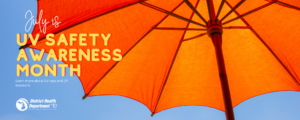
Key Facts
According to the American Cancer Society:
- Your skin makes vitamin D naturally when it is exposed to UV rays from the sun. Whenever possible, it’s better to get vitamin D from your diet or vitamin supplements rather than from exposure to UV rays.
- Dietary sources and vitamin supplements do not increase skin cancer risk, and are typically more reliable ways to get the amount you need.
- It is important to limit your exposure by taking the following actions.
- Staying in the shade, especially during 10AM – 4PM.
- Protecting your skin with clothing that covers your arms and legs.
- Wearing a hat to protect your head, face, and neck.
- Wearing sunglasses that block UV rays to protect your eyes and the skin around them.
- Using sunscreen to help protect skin that isn’t covered with clothing.
According to the Centers for Disease Control and Prevention (CDC), Ultraviolet (UV) radiation is a form of non-ionizing radiation that is emitted by the sun and artificial sources. The beneficial effects of UV radiation include the production of a vital nutrient, vitamin D. However, overexposure may present risks. Sunburn, premature aging, and skin cancer are all risks to overexposure. Keeping you and others protected from UV radiation is an important year-round.
How are people exposed to UV radiation?
Sunlight is the main source of UV radiation, however there are artificial sources like tanning beds and welding torches.
What affects UV exposure?
The strength of the sun’s UV rays reaching the ground depends on a number of factors, such as:
- Time of day: UV rays are strongest between 10 am and 4 pm.
- Season of the year: UV rays are stronger during spring and summer months. This is less of a factor near the equator.
- Distance from the equator (latitude): UV exposure goes down as you get farther from the equator.
- Altitude: More UV rays reach the ground at higher elevations.
- Clouds: The effect of clouds can vary, but what’s important to know is that UV rays can get through to the ground, even on a cloudy day.
- Reflection off surfaces: UV rays can bounce off surfaces like water, sand, snow, pavement, or even grass, leading to an increase in UV exposure.
- Contents of the air: Ozone in the upper atmosphere, for example, filters out some UV radiation.
Tips to protect yourself from the sun
- Stay in the shade, especially during midday hours.
- Wear clothes that cover your arms and legs.
- Wear a hat with a wide brim to shade your face, head, ears, and neck.
- Wear sunglasses that wrap around and block both UVA and UVB rays.
- Use sunscreen with sun protection factor (SPF) 15 or higher, and both UVA and UVB protection.
Tips to protect children from the sun
Children need special attention. They tend to spend more time outdoors, can burn more easily, and may not be aware of the dangers. Parents and other caregivers should protect children from excess sun exposure by using the steps above. It’s important, particularly in sunnier parts of the world, to cover your children as fully as is reasonable.
You should develop the habit of using sunscreen on exposed skin for yourself and your children whenever you go outdoors and may be exposed to large amounts of sunlight.
Children need to be taught about the dangers of too much sun exposure as they become more independent. If you or your child burns easily, be extra careful to cover up, limit exposure, and apply sunscreen.
Babies younger than 6 months should be kept out of direct sunlight and protected from the sun using hats and protective clothing. Sunscreen may be used on small areas of exposed skin only if adequate clothing and shade are not available.
Are there any health issues related to UV radiation?
- Most skin cancers are caused by too much exposure to ultraviolet (UV) rays. Most of this exposure comes from the sun, but some can come from man-made sources, such as indoor tanning beds and sun lamps. People who get a lot of exposure to UV rays are at greater risk for skin cancer.
- UV rays, either from the sun or from artificial sources like tanning beds, can cause sunburn.
- Exposure to UV rays can cause premature aging of the skin and signs of sun damage such as wrinkles, leathery skin, liver spots, actinic keratosis, and solar elastosis.
- UV rays can also cause eye problems. They can cause the cornea (on the front of the eye) to become inflamed or burned. They can also lead to the formation of cataracts (clouding of the lens of the eye) and pterygium (tissue growth on the surface of the eye), both of which can impair vision.
- Exposure to UV rays can also weaken the immune system, so that the body has a harder time fending off infections. This can lead to problems such as reactivation of herpes triggered by exposure to the sun or other sources of UV rays. It can also cause vaccines to be less effective.
Quick Links:
